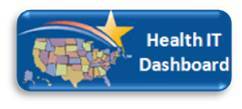Health IT Datasets & Statistics
The ONC’s Health IT Dashboard presents key information and data to enable collaborative monitoring of the impact of federal policies, programs, and research activities related to health IT. Datasets and statistics are updated regularly. There are five major interactive dashboard to explore.
The ONC Overview Dashboard includes summary information about all of ONC’s HITECH grant programs, including their location, funding amount, and contact information. Interact with this dashboard to:
- Generate maps of ONC’s planned obligations by state and program (data does not include sub recipients or contracts servicing ONC grants).
- Learn how ONC’s HITECH programs work together to create momentum in EHR adoption and health information exchange activity.
- Download a full list of ONC HITECH program grantees for your own purposes.
The Health IT Adoption & Use Dashboard presents ONC state summary estimates for the rate of electronic health record (EHR) adoption among office-based physicians and hospitals. Interact with this dashboard to:
- See state rates of EHR adoption among office-based providers including EHR adoption estimates for providers in primary care, small, and rural practices.
- Discover state rates of hospital adoption of EHRs according to overall, small, and rural hospital groups.
- Explore state and county level data on health information exchange, including rates of e-prescribing activity and health care provider supply.
- Download and analyze the data for your own purposes.
The Health IT Regional Extension Center Program dashboard tracks monthly progress to the programs primary care provider EHR adoption goals. The Dashboard includes over 60 custom reports covering 30+ key measures at the national, grantee, state, and county level. Interact with this dashboard to:
- Examine how the REC program accomplishing its goals by reviewing patterns provider attainment of EHR adoption milestones across a range of important health care provider demographics.
- Evaluate the REC program and grantees progress using the demographics of providers working with RECs according to practice area, specialty, setting and more.
- Download and analyze the data for your own purposes.
The Health IT Workforce Dashboard includes summary information about the Community College Consortia to Educate Health IT Professionals Program, including location of grantees, and progress to health IT workforce development goals. Interact with this dashboard to:
- Find out which community colleges and universities in your area are participating in the ONC Health IT workforce Programs.
- See how many professionals in your area have been trained by the Community College Consortia to Educate Health IT Professionals program.
- Download and analyze the data for your own purposes.
The Datasets & Documentation page provides direct access to all of the content underlying the Health IT Dashboards, including each individual dataset and data dictionary, along with other related data briefs and materials. Interact with this dashboard to:
- Download and analyze ONC’s research and program performance data for your own purposes.
- Use datasets that are predictably organized and published often to create your own web services and APIs that are connected to ONC data.
- Learn how ONC’s HITECH programs work together to create momentum in EHR adoption and health information exchange activity.
New web content presents some of the initial results from ONC’s research and monitoring into patterns of health care provider adoption and use of electronic health records (EHR). Some key questions answered by ONC’s Health IT Dashboard include:
- What is the percent of office-based health care providers that have adopted EHRs in my state?
- How many health IT implementation support professionals have been trained by community colleges (ONC grantees) in my state?
- What is the percentage of pharmacies that are enabled and actively using electronic prescribing (e-prescribing) technologies in my county or state?
- How many providers (all or primary care only) are in my county or state?

